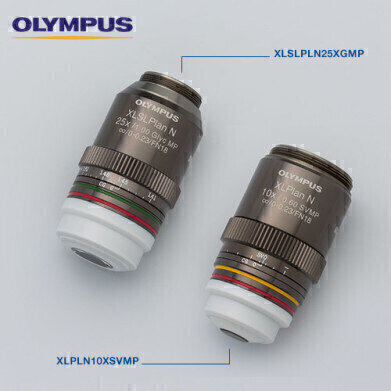Microscopy & Microtechniques
New MPE objectives for the clearest deep imaging
Sep 03 2014
Dedicated to multiphoton excitation microscopy, Olympus introduces its XLPLN10XSVMP and XLSLPLN25XGMP objective lenses with an 8mm working distance and support for a large range of refractive indices (RI). The objectives enable super-deep imaging of tissues treated with the latest clearing agents as well as live-cell imaging and light sheet microscopy techniques.
Compatible with the industry leading FVMPE-RS and FV1200MPE multiphoton microscopy systems and easily adaptable to home-build light sheet microscopes, the new objectives boast a range of features providing important benefits to researchers. Both objectives offer super-long working distances of 8 mm, providing the capability and space for structural and live-cell imaging deep within large intact samples (such as whole mouse brain), especially useful in neuroscience applications. A high transmittance range of 400-1600nm extending into the infra-red spectrum, allows deeper imaging with minimal damage to the tissue and is well-suited to combine conventional multi-colour MPE imaging with label-free methods like third- and second-harmonic generation. A field number of 27.5 provides excellent scattered light collecting abilities and a correction collar allows compensation of refractive index mismatches. Furthermore, spherical aberrations are corrected across the visible to infra-red (IR) range, with additional chromatic aberration correction in the IR range.
The XPLN10XSVMP is also extremely versatile with multi-immersion capability enabling its use with water, silicone and oil as well as clearing agents such as SCALEVIEW (1), Clarity (2) and SeeDB (3). Deep macro observation is achieved with high resolution at a large field of view (FOV – 1.8mm at 10X magnification). The XLSLPLN25XGMP also supports the latest in clearing agents such as Clarity and SeeDB for cutting-edge research techniques, aided by a high RI immersion capability of 1.41-1.52 (SeeDB requires an RI of 1.49).
These additions to Olympus’ XLPLN series of objectives extend the company’s lead in the field of multiphoton excitation microscopy. The objectives enable the interrogation of large intact samples (such as whole-brain high-resolution imaging) and structural and molecular analysis of large assembled biological systems. The large FOV provided by the objectives enhances data collection from samples treated with the latest clearing agents by several orders of magnitude and this combined with unsurpassed flexibility and correctional capabilities makes them the clear choice for researchers using MPE or light sheet microscopy techniques.
References:
(1) Tomer R, Li Y, Hsueh B, Deisseroth K, Nature protocols 9 (7), 1682-1697 (2014 - published online 19 June 2014); doi:10.1038/nprot.2014.123
(2) Chung K, Deisseroth K, Nature Methods 10, 508-513 (2013); doi 10.1038/nmeth.2481
(3) Ke MT, Fujimoto S, Imai T, Nature Neuroscience 6 (8), 1154-1161 (2013); doi: 10.1038/nn.3447
Digital Edition
Lab Asia 31.2 April 2024
April 2024
In This Edition Chromatography Articles - Approaches to troubleshooting an SPE method for the analysis of oligonucleotides (pt i) - High-precision liquid flow processes demand full fluidic c...
View all digital editions
Events
Apr 28 2024 Montreal, Quebec, Canada
May 05 2024 Seville, Spain
InformEx Zone at CPhl North America
May 07 2024 Pennsylvania, PA, USA
May 14 2024 Oklahoma City, OK, USA
May 15 2024 Birmingham, UK


















